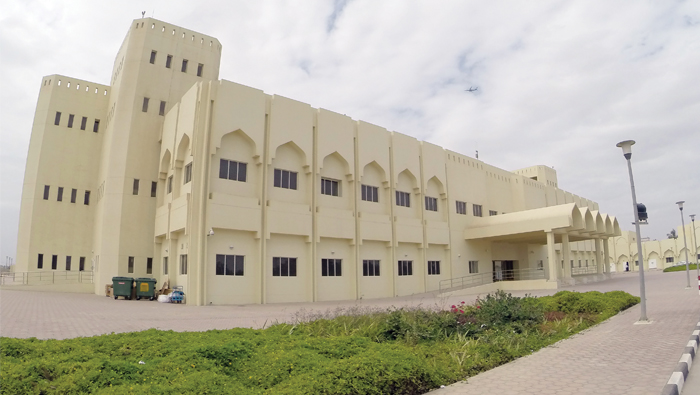
Muscat: Oman’s health sector has developed tremendously over the past years from having only two hospitals during early 1970 with 12 beds and 10 clinics to now having a national total of 81 hospitals.
Out of these 81 hospitals, 50 are run under the Ministry of Health (MoH) with a total of 5,027 hospital beds, according to the MoH’s Annual Health Report 2018.
In its support for primary healthcare, MoH opened one new Health Centre in Muscat and Al Wusta Governorate and upgraded one health centre to Hospital with 14 beds in Dhofar Governorate.
This makes the total number of health centres 207 of which 55 are equipped with beds (a total of 95 beds), and 22 extended health centres in the MoH. This comes a long way from having 19 health centres in the early 1970 with zero beds in it, and no extended health centres, according to the data provided in MoH’s annual report 2018.
From a life expectancy of 50 years in the 70s, the country has a life expectancy of 77 years at present. The country is also witnessing a shift in its main health problems from communicable diseases to changes in life style and changes in population structure manifested in non-communicable diseases.
Talking to the Times of Oman in an exclusive interview in June 2018, Dr Ahmed bin Mohammed Al Saidi, Minister of Health, had said, “In 1970, when (the late) His Majesty Sultan Qaboos bin Said bin Taimur became the Sultan of Oman, life expectancy in the country was only 50 years. The mortality rates among pregnant women, infants less than one year and children below five years were one of the highest worldwide.”
He added that “about 200 per 1,000 live births of children below five didn’t live to see their fifth birthday. Today, our life expectancy has exceeded over 76 years, and the mortality rate in children below five has declined to 9.5 per cent from 20 per cent in the 70s.”
Al Saidi continued saying that when the late HM Sultan Qaboos became the ruler, he prioritised education and health.
“When His Majesty became the ruler and started building Oman, he made education and health a priority in addition to the security. So, school and healthcare facilities started building across the country,” recalled Al Saidi.
“My predecessors worked very hard and established the basic needs and facilities of health care in the country. Their concentration was on primary healthcare which is extremely important,” he added.
Since 1976, the MoH started its five-year health development plans, in order to achieve its mission and carry out its responsibilities for social and economic development.
“The first phase of the health planning in Sultanate of Oman extended from 1976 to 1990, in which three 5-year plans were implemented. These plans were concerned with building health service infrastructure as prior to the blessed renaissance there were only few health institutions that were not enough to face the prevailing unsatisfactory health status. The second phase of planning started in 1991 and included three 5-year health plans (the fourth, fifth and sixth), and was completed by 2005,” the report said.
In 1993 the local directorates at a wilayat level were established followed by hospital autonomy in the year of 2000. The preparation of plans of the second phase followed “the managerial process for national health development”.
“The general framework of the 4th, 5th and 6th plans was prepared at the central level. The 5th and 6th plans included 10 detailed governmental plans while the 6th plan included an additional 19 Wilayat plans, in line with the decentralisation policy of the Ministry of Health,” the report added.
Several hospitals were established in all governorates in order to provide specialty services mainly secondary care and limited tertiary care. Human resource development was emphasised with the establishment of training health institutes to qualify staff in the field of nursing, medical laboratories, radiography, assistant dentists, assistant pharmacists, health inspectors and other paramedical fields.
Supportive plans at the wilayat level were also designed by the wilayat health committees to support the government’s operational plans.
A fourth stage of planning was started in 2011 by the beginning of the development of "Health Vision 2050". This stage witnessed the development of a vision on how health system needs to be in the following 40 years and was accompanied by the designing and publishing of the Health Atlas 2050 and a number of strategic studies.
Today, the MoH provides health services to all the people of Oman through its health institutions. It also attempted to strengthen health services outside the Muscat governorate. Therefore, an umbrella of health services was established to cover the entire Sultanate.
“There is a Governorate Hospital in each health governorate that provides secondary care (tertiary in some) for the people in its catchment area. This is in addition to the Wilayat Hospitals, Local Hospitals and Health Centres in each health governorate,” the 2018 annual report read.
In addition to that, besides primary healthcare services, MoH also realised the importance of secondary and tertiary care services to face the changes in disease trends and the future needs to control and treat non-communicable diseases.
“The MoH has equipped its hospitals with sufficient number of beds in various specialties. During 2015, three specialised centres – Cardiac, Diabetic and Genetic and Hereditary Diseases in Muscat govenorate, attached to Royal Hopsital, Cardiac centre in Dhofar Governorate attached to Sultan Qaboos Hospital and Diabetic Centre at Sur, attached to Sur Extended Health centre,” the report said.